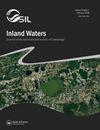热稳定性对春季沼泽微甲壳类动物群落的影响
IF 2.3
3区 环境科学与生态学
Q1 LIMNOLOGY
引用次数: 0
摘要
摘要泉被认为是相对稳定的水生环境,也是气候变化下适应寒冷的类群可能的热避难所。然而,西喀尔巴阡山脉的永久性和原始春季围栏显示出热稳定性的站点间变化,对大型无脊椎动物组合产生了重大影响。在这项研究中,我们研究了热稳定性对微尺度尺度尺度尺度的影响。我们解开了热稳定性的各种参数,如夏季和冬季平均温度、年振幅和日波动,并将这些参数与中气候、植被覆盖和地下水位联系起来。我们发现,随着夏季平均水温的升高,低温狭热物种的相对丰度显著降低,这对物种组成有显著影响。令人惊讶的是,介形虫对热稳定性完全漠不关心,尽管包括冷的狭热介形虫和克里诺比翁介形虫,这表明这些物种可能具有更广泛的耐热性。相比之下,叉交酯对夏季和冬季平均温度都有显著的反应,显示出耐热性的上限和下限。虽然植被覆盖显著抑制了夏季的日波动,但未发现日波动对微尺度尺度的影响。地下水位的影响也很显著,但与热稳定性无关。我们假设,随着空气温度的升高,热稳定性较低的部位将不支持冷的窄热harpraticoid的发生。然而,冬季温度的升高可能会导致鱼叉类动物的总体丰度更高。我们讨论了春季沼泽地可能受到干旱和气温升高的最大威胁。本文章由计算机程序翻译,如有差异,请以英文原文为准。
Effects of thermal stability on microcrustacean assemblages in spring fens
ABSTRACT Springs are considered relatively stable aquatic environments and possible thermal refugia for cold-adapted taxa under climate change. However, permanent and pristine spring fens in the Western Carpathians show between-site variation in thermal stability with significant effects on macroinvertebrate assemblages. In this study, we investigated the impact of the thermal stability on microcrustaceans (Harpacticoida, Ostracoda). We disentangled various parameters of thermal stability, such as mean summer and winter temperatures, annual amplitude, and daily fluctuations, and related these parameters to mesoclimate, vegetation cover, and water table. We found that the relative abundance of cold-stenothermal species decreased significantly with increasing mean water temperature in summer, which had a significant effect on species composition. Surprisingly, ostracods were completely indifferent to thermal stability despite including cold stenotherms and crenobionts, suggesting that these species might have broader thermal tolerance. By contrast, harpacticoids significantly responded to both summer and winter mean temperatures, showing upper and lower limits of thermal tolerance. While vegetation cover significantly suppressed daily fluctuations in summer, no effect of daily fluctuations on microcrustaceans was found. The effect of water table was also significant but independent of thermal stability. We assume that the less thermally stable sites will not support the occurrence of cold-stenothermic harpacticoids as air temperature rises. However, an increase in winter temperatures may result in higher overall abundance of harpacticoids. We discuss how spring fens are probably most threatened by the combination of drought and increasing temperature.
求助全文
通过发布文献求助,成功后即可免费获取论文全文。
去求助
来源期刊

Inland Waters
LIMNOLOGY-MARINE & FRESHWATER BIOLOGY
CiteScore
6.10
自引率
9.70%
发文量
34
审稿时长
>12 weeks
期刊介绍:
Inland Waters is the peer-reviewed, scholarly outlet for original papers that advance science within the framework of the International Society of Limnology (SIL). The journal promotes understanding of inland aquatic ecosystems and their management. Subject matter parallels the content of SIL Congresses, and submissions based on presentations are encouraged.
All aspects of physical, chemical, and biological limnology are appropriate, as are papers on applied and regional limnology. The journal also aims to publish articles resulting from plenary lectures presented at SIL Congresses and occasional synthesis articles, as well as issues dedicated to a particular theme, specific water body, or aquatic ecosystem in a geographical area. Publication in the journal is not restricted to SIL members.
 求助内容:
求助内容: 应助结果提醒方式:
应助结果提醒方式:


